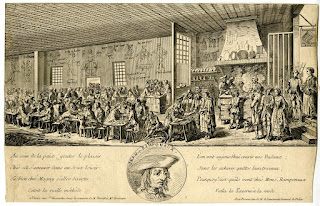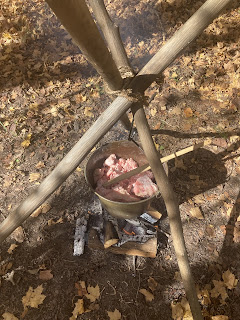https://www.britishmuseum.org/collection/object/P_1861-1012-270
This is my holiday gift to all of you! When looking for something else I stumbled upon this absolute gem!
This is a circa 1758, French etching published by Parvillé in Paris. It advertises the interior of the tavern of Monsieur Ramponneau. Please go to the above link at the British Museum and zoom in to see what the figures are up to! From finely dressed gentlemen and women to lowly vomiting fishmongers
it seems all were welcome at the Royal Drum!
The walls are adorned with murals of lively characters captioned in French and Latin.
Pitchers line the walls and their contents flow freely from rather frazzled looking wait staff.
A large hearth appears to be churning out fish as each table appears laden with food.
The closest I’ve gotten to the Ramponneau´s experience was at Grandchamps Restaurent in recreated Fortress Louisbourg, Nova Scotia. The pictures on trip advisor show the same fairly small dining room with white washed walls and historical, graffiti-esque drawings scrawled on the walls that I do fondly remember. The reviews are unfortunately very poor but I disagree wholeheartedly. Grandchamps offers a uniquely authentic recreated experience unrivaled anywhere on this continent. And you can tell Josiah Chowning I said that.
In 2008 when I was there for the 250th commemoration of the Siege of Fortress Louisbourg, I was very impressed with the place. It was full of reenactors and I mean f u l l and it felt like I always imagined a colonial tavern would. I distinctly remember in particular a large drawing of Bacchus straddling a keg which I loved as a 19 year old in a foreign country able to drink alcohol legally for the first time.
So when I found this image of Ramponneau´s at the Royal Drum I was thrilled to see Bachus once again, which is what made me slide down this rabbit hole in the first place.
gallus cantavit (the Latin) le coq a chanté (french) meaning the rooster crowed.
suis j'ay soif- Am I thirsty
I like that this guy is bringing his own pitcher. I’m not sure if that was normal or if it’s just a joke. Any insight would be appreciated.
 Bachus -Dionysus (/daɪ.əˈnaɪsəs/; Ancient Greek: Διόνυσος Dionysos) is the god of the grape-harvest, winemaking, orchards and fruit, vegetation, fertility, insanity, ritual madness, religious ecstasy, festivity, and theatre in ancient Greek religion and myth. He is also known as Bacchus (/ˈbækəs/ or /ˈbɑːkəs/; Ancient Greek: Βάκχος Bacchos) by the Greeks. This name was later adopted by the Romans;
Bachus -Dionysus (/daɪ.əˈnaɪsəs/; Ancient Greek: Διόνυσος Dionysos) is the god of the grape-harvest, winemaking, orchards and fruit, vegetation, fertility, insanity, ritual madness, religious ecstasy, festivity, and theatre in ancient Greek religion and myth. He is also known as Bacchus (/ˈbækəs/ or /ˈbɑːkəs/; Ancient Greek: Βάκχος Bacchos) by the Greeks. This name was later adopted by the Romans;Credit is dead- I love this one, this has great energy. I’m. It sure who the figure in the drawing is but perhaps someone Royal? Maybe Monsieur Ramponneau himself?
la camargot- Marie Anne de Cupis de Camargo (15 April 1710 in Brussels – 28 April 1770 in Paris), sometimes known simply as La Camargo, was a French dancer. The first woman to execute the entrechat quatre, Camargo was also allegedly responsible for two innovations in ballet as she was one of the first dancers to wear slippers instead of heeled shoes, and, while there is no evidence that she was the first woman to wear the short calf-length ballet skirt, the now standardized ballet tights she did help to popularize these. She is said to have been as strong as the male dancers.
And her dance partner Good mood!
The center of the print has a portrait of the tavern’s owner flanked by a descriptive advertisement.
The original French:
Au sein de la paix, gouter le plaisir / / Oû bien chez Magny s’aller divertir / C’etoit la vieille méthôde / a Paris rue S.te Hyachinthe dans la maison de M. Parvillée M.e Ecrivain
L’on voit aujourd’hui courir nos Badaux; / Sans les achever quitter leurs travaux; / Pourquoy? c’est qu ils vont chés Mons Ramponaux / Voila la Taverne a la mode / Avec Permission de M. le Lieutenant General de Police
Today we see our Badaux running; / Without completing them leave their work; / Why? it's that they go to Mons Ramponaux / Here is the fashionable tavern / With Permission from the Lieutenant General of Police
In the midst of peace, enjoy pleasure / At home have fun in a sweet leisure / Or go to Magny to have fun / It was the old method / in Paris rue S.te Hyachinthe in the house of M. Parvillée M.e Writer
Again, I’m not entirely sure what all of the references mean but I love the sentiment. This ad would have had ME running to Mons Ramponaux tavern!
I hope you enjoyed my deep dive into this etching as much as I did!





























